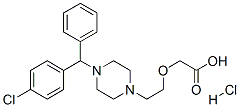| Description |
Cetirizine hydrochloride is an orally-active and selective histamine (H1)-receptor antagonist. It is a second-generation antihistamine and a human metabolite of hydroxyzine. Three important features of cetirizine are: a high specificity fort he H1-receptor; a low need for metabolism, and the existence of non-H1-dependent activities on cells involved in the pathogenesis of allergy.
Cetirizine is used to treat seasonal allergic rhinitis (SAR), perennial allergic rhinitis, useful in treating urticaria and atopic dermatitis. Cetirizine possesses also mild anti-inflammatory effects. |
| References |
[1] E. J. Corey and Christopher J. Helal, Catalytic Enantioselective Synthesis of the Second-Generation Histamine Antagonist Cetirizine Hydrochloride, Tetrahedron Letters, 1996, vol. 37, 4837-4840
[2] Jay M. Portnoy and Chitra Dinakar, Review of cetirizine hydrochloride for the treatment of allergic disorders, Journal of Expert Opinion on Pharmacotherapy, 2004, vol. 5, 125-135 |
| Chemical Properties |
Crystalline Solid |
| Uses |
respiratory stimulant |
| Uses |
A nonsedating type histamine H1-receptor antagonist. A major metabolite of Hydroxyzine. Pharmacological activity resides primarily in the (R)-isomer. Antihystaminic. |
| Uses |
long acting calcium channel blocker |
| Uses |
Antihistaminic |
| Biological Activity |
Histamine H 1 receptor antagonist that displays selectivity over other receptors at concentrations up to 10 μ M. A non-sedating antihistamine that inhibits histamine release and eosinophil chemotaxis during secondary phase allergic response. Inhibits activation of eosinophils, neutrophils and monocytes in vivo . |

 China
China







